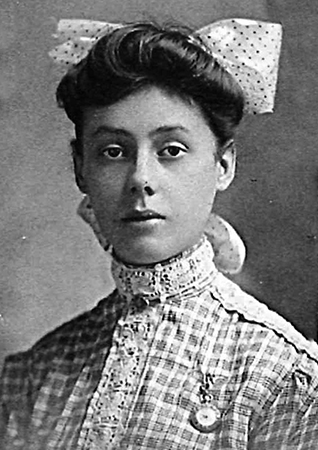Dandelion Cottage was a real place, and its story is yet another example of how Marquette seeks to preserve its past.
No one knows when the cottage was initially built, but Peter White, who owned it as a rental property, donated it in 1888 to St. Paul’s with the understanding that it would be moved from its original home on High Street, a couple of hundred feet north to 212 E. Arch Street, behind the church. White had it moved to make room to build the Morgan Memorial Chapel.
The cottage would remain at its second location for 103 years and soon become famous.
 In 1904, the house became known as “Dandelion Cottage” after Carroll Watson Rankin wrote her children’s book of the same name with the cottage at its center. The story is a fictional account of four girls, loosely based on Mrs. Rankin’s daughters and their friends. The characters, Bettie, Jeanie, Mabel, and Marjory, earn the right to use the cottage as their playhouse for the summer in exchange for picking the dandelions from the cottage’s lawn.
In 1904, the house became known as “Dandelion Cottage” after Carroll Watson Rankin wrote her children’s book of the same name with the cottage at its center. The story is a fictional account of four girls, loosely based on Mrs. Rankin’s daughters and their friends. The characters, Bettie, Jeanie, Mabel, and Marjory, earn the right to use the cottage as their playhouse for the summer in exchange for picking the dandelions from the cottage’s lawn.
Although the girl’s antics and adventures are largely fictional, dandelions were a problem in early Marquette. John M. Longyear recalled a contest held to see which child could collect the most dandelions in Marquette, but the contest, despite its popularity, and three-thousand, five hundred bushels of dandelions being collected, did not rid the city of its weeds. Another possible real-life source is the character of Mr. Black, rumored to be a fictional portrait of Peter White.
While the cottage’s notoriety grew throughout the twentieth century along with the popularity of Dandelion Cottage and Mrs. Rankin’s other books, it remained a rental property for the church. Then in 1988, St. Paul’s decided it needed to expand its parking lot and Dandelion Cottage and the other small house beside it were in the way.
Thankfully, the church acknowledged the historical significance of Dandelion Cottage, so rather than simply tear it down, it sought someone to buy it for the sum of $1.00 and then move it. The church did not give up easily, and after three years, in early 1991, Mayor William Birch and his wife Sally came forward to purchase and move the cottage. On October 12, 1991, the cottage was moved to its present location, which was directly behind the Birchs’ Ridge Street home.
 The Mining Journal ran numerous stories about the attempts to sell the cottage and its successive move. Estimates to relocate it two blocks down Arch Street were said to be $20,000. But the Birchs went beyond just moving it. Dandelion Cottage was given a beautiful restoration. It was repainted yellow, remodeled inside with a modern kitchen, woodwork was replaced and where possible replicated to match the original hardwood; the maple floors were refinished, and dandelions stenciled on the walls. In all, the restoration cost over $60,000, but William and Sally Birch understood that if a thing is worth doing, it is worth doing well. Soon after, Phyllis Rankin, the then ninety-seven-year-old daughter of the author, suggested a state historical marker be sought which today appears on the cottage.
The Mining Journal ran numerous stories about the attempts to sell the cottage and its successive move. Estimates to relocate it two blocks down Arch Street were said to be $20,000. But the Birchs went beyond just moving it. Dandelion Cottage was given a beautiful restoration. It was repainted yellow, remodeled inside with a modern kitchen, woodwork was replaced and where possible replicated to match the original hardwood; the maple floors were refinished, and dandelions stenciled on the walls. In all, the restoration cost over $60,000, but William and Sally Birch understood that if a thing is worth doing, it is worth doing well. Soon after, Phyllis Rankin, the then ninety-seven-year-old daughter of the author, suggested a state historical marker be sought which today appears on the cottage.
June 28, 1992 was a gala day when Dandelion Cottage was opened to the public. My brother and I were among the many who stood in a long line down Arch Street to tour the newly restored historic cottage. I doubt a single visitor was anything but pleased and grateful that this Marquette landmark was preserved. Phyllis Rankin told The Mining Journal, “I am glad it was saved and I know my mother would have been delighted about it. It looks lovely… It’s a beautiful job.”
The cottage has since been resold and continues as a residence. Visitors to Marquette make a point to seek it out, and customer reviews at Amazon reveal that Dandelion Cottage remains a favorite among readers, and the Marquette County History Museum sells numerous copies of the book each year. What appears as a weed can turn out to be a gift to future generations.
This is an excerpt from My Marquette by Tyler Tichelaar



